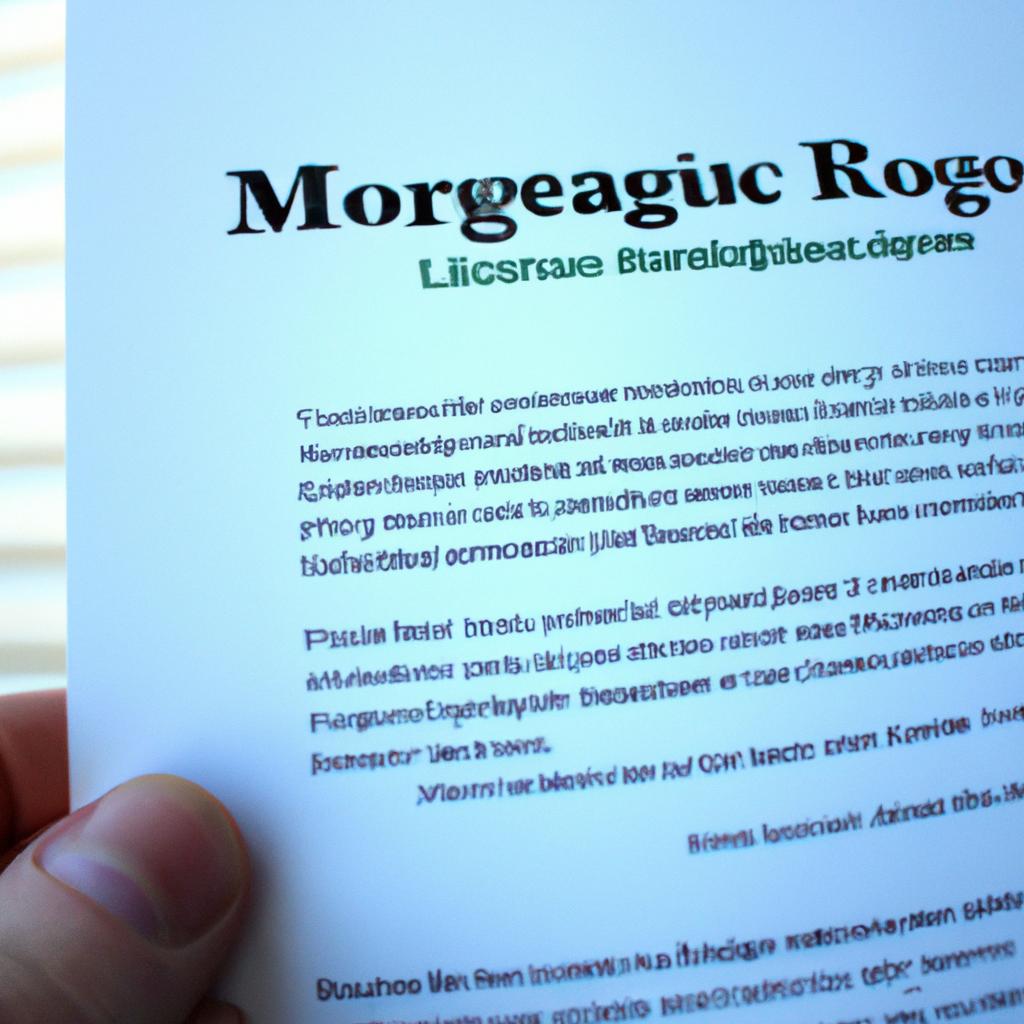One of the most significant hurdles to homeownership for many individuals is saving enough money for a down payment. The down payment is an upfront sum paid towards the purchase price of a home and typically represents a percentage of the total cost. For instance, in a hypothetical scenario, let’s consider John, who wants to buy his first home priced at $300,000. Assuming he needs to make a 20% down payment, John would have to save $60,000 before being able to secure his dream home.
Mortgage pre-approval is one option that potential homebuyers like John can explore to facilitate their down payment process. Mortgage pre-approval refers to the lender’s assessment of an individual’s creditworthiness and ability to repay a loan based on certain predetermined criteria. This evaluation provides buyers with valuable insights into how much they can afford as well as streamlines the mortgage application process. By obtaining pre-approval prior to searching for homes, prospective buyers gain confidence in knowing what price range they should be considering and can act quickly when making offers without worrying about financing contingencies. In this article, we will delve deeper into various down payment options available to buyers and examine why obtaining mortgage pre-approval plays such a vital role in achieving homeowners hip.
Obtaining mortgage pre-approval plays such a vital role in achieving homeownership because it provides potential buyers with a clear understanding of their financial situation and borrowing capacity. Here are some reasons why mortgage pre-approval is important:
-
Budgeting: Mortgage pre-approval helps buyers determine how much they can afford to spend on a home. It takes into account factors such as income, debts, and credit history to provide an accurate estimate of the loan amount for which they may qualify. This information allows buyers to set a realistic budget and avoid wasting time looking at homes that are outside their price range.
-
Negotiating Power: When making an offer on a home, having mortgage pre-approval gives buyers an advantage over those who have not been pre-approved. Sellers often prefer working with buyers who have already secured financing as it reduces the risk of the deal falling through due to financing issues. Pre-approval demonstrates that the buyer is serious and financially capable, increasing their chances of having their offer accepted.
-
Time Savings: With mortgage pre-approval, buyers can expedite the homebuying process. They have already provided all necessary financial documents to the lender during the pre-approval process, which means less paperwork when applying for an actual mortgage. This saves time and allows buyers to act quickly when they find their dream home.
-
Confidence: Knowing that they have been pre-approved for a mortgage gives buyers confidence throughout the homebuying process. They can focus on finding the right property without worrying about whether or not they will be able to secure financing.
In conclusion, obtaining mortgage pre-approval is crucial for prospective homebuyers because it provides them with financial clarity, negotiating power, time savings, and confidence in pursuing homeownership. It is an essential step towards achieving one’s goal of owning a home by streamlining the down payment process and facilitating smoother transactions in the real estate market.
Different Down Payment Options
One of the key considerations when purchasing a home is determining the down payment amount. The down payment is an upfront payment made by the buyer, typically expressed as a percentage of the total purchase price. While the standard down payment requirement is 20% of the home’s value, there are various options available for buyers who may not have this amount readily available.
For instance, let’s consider a hypothetical scenario where John and Sarah are looking to buy their first home. They have been diligently saving money but currently only have 10% of the purchase price saved up. In this situation, they would need to explore alternative down payment options in order to proceed with their homeownership goals.
One option available to individuals like John and Sarah is obtaining mortgage loan pre-approval. This process involves applying for a mortgage loan from a lender before starting house hunting. By doing so, potential buyers can gain insight into how much they qualify for and what down payment options are available to them based on their financial situation.
To further illustrate different down payment options, consider the following bullet points:
- Low-down-payment mortgages: These types of loans allow borrowers to put as little as 3% or even 0% down on a property.
- Government-backed loans: Programs such as FHA (Federal Housing Administration) loans offer more flexible requirements and lower down payments compared to conventional mortgages.
- Assistance programs: Some states and municipalities provide assistance programs that help low-income families with their down payments.
- Gift funds: Buyers may also receive gift funds from family members or friends to assist with their down payment.
Moreover, it can be helpful to visualize these alternatives through a table:
| Type of Loan | Minimum Down Payment Requirement |
|---|---|
| Conventional Mortgage | 5%-20% |
| FHA Loan | As low as 3.5% |
| VA Loan | No down payment required |
| USDA Loan | No down payment required |
By exploring these various options, potential homebuyers can identify the most suitable solution for their financial circumstances. Understanding the available choices allows individuals to make informed decisions and take advantage of opportunities that may help them achieve their homeownership goals.
Transitioning into the subsequent section about “Understanding Loan-to-Value Ratio,” it is important to note that while the down payment amount plays a significant role in purchasing a home, it is equally essential to consider the loan-to-value ratio. This ratio will be discussed in detail in the following section, shedding light on its impact on mortgage terms and interest rates.
Understanding Loan-to-Value Ratio
Having explored various down payment options, it is crucial to understand how these choices can affect your loan-to-value ratio. By comprehending this concept, you will be better equipped to make informed decisions when seeking mortgage pre-approval.
Understanding Loan-to-Value Ratio:
To illustrate the significance of loan-to-value ratio (LTV), let’s consider a hypothetical scenario where John intends to purchase a $300,000 home with an initial down payment of $60,000. In this case, his LTV would be calculated by dividing the remaining loan amount ($240,000) by the appraised value of the property ($300,000). This results in an LTV ratio of 80%.
The loan-to-value ratio plays a crucial role in determining several aspects related to obtaining a mortgage and securing pre-approval. Here are key points to keep in mind:
- A lower LTV generally indicates less risk for lenders and often leads to more favorable terms.
- Higher LTV ratios may require additional insurance or result in higher interest rates as they represent increased lender exposure.
- It is essential to evaluate different down payment options based on their potential impact on your LTV.
To provide further clarity on this topic, here is a table showcasing varying scenarios and their corresponding loan-to-value ratios:
| Scenario | Home Price | Down Payment | Loan Amount | LTV Ratio |
|---|---|---|---|---|
| Preferred Option | $400,000 | $100,000 (25% DP) | $300,000 | 75% |
| Alternative Option 1 | $400,000 | $80,000 (20% DP) | $320,000 | 80% |
| Alternative Option 2 | $400,000 | $60,000 (15% DP) | $340,000 | 85% |
| Risky Option | $400,000 | $40,000 (10% DP) | $360,000 | 90% |
In summary, understanding the loan-to-value ratio is crucial when considering different down payment options for mortgage pre-approval. By analyzing this ratio and its impact on interest rates and potential insurance requirements, you can make an informed decision that aligns with your financial goals and risk tolerance.
Now let’s explore the pros and cons of a larger down payment and how it can influence your mortgage journey.
Pros and Cons of a Larger Down Payment
Having gained an understanding of the loan-to-value ratio, let us now explore the pros and cons of opting for a larger down payment. To illustrate these points, consider the following hypothetical scenario:
Hypothetical Example:
Imagine you are purchasing a house worth $300,000. With a 20% down payment ($60,000), you secure a mortgage loan for the remaining amount ($240,000). Alternatively, if you decide to make only a 10% down payment ($30,000), your loan amount increases to $270,000.
Pros and Cons of a Larger Down Payment:
-
Lower Monthly Payments:
- By making a larger down payment, you reduce the principal amount borrowed from the lender.
- This leads to lower monthly mortgage payments since interest is calculated based on the outstanding balance.
- A smaller mortgage payment can provide financial stability and allow for increased savings or investment opportunities.
-
Interest Savings:
- Making a substantial down payment reduces the overall interest paid over the life of your mortgage.
- Lowering your loan amount decreases both the principal that accrues interest and the total number of months required to repay it fully.
- Over time, this can result in significant savings on interest expenses.
-
Increased Equity:
- A larger down payment immediately provides more equity in your home.
- Having higher equity offers greater protection against potential market fluctuations or unexpected circumstances.
- It also opens up possibilities for refinancing at better terms in the future.
-
Opportunity Cost Considerations:
- While putting more money towards a down payment has its advantages, it’s essential to evaluate opportunity costs associated with tying up extra funds in your property.
- Investing those funds elsewhere may yield higher returns or provide flexibility for other financial goals.
- Weighing these opportunity costs is crucial in deciding the optimal down payment amount.
| Pros of a Larger Down Payment | Cons of a Larger Down Payment |
|---|---|
| Lower monthly mortgage payments | Tying up more funds in property |
| Reduced interest expenses over time | Potential limitations on liquidity and investments |
| Increased equity protection | Risk of missing out on higher investment returns |
| Might secure better refinancing terms in the future |
In conclusion, making a larger down payment offers several advantages such as lower monthly payments, reduced interest expenses, increased equity, and potential access to better refinancing terms. However, it’s essential to consider the opportunity costs associated with tying up additional funds in your property. Evaluating personal financial goals and weighing these factors will help determine the most suitable down payment amount for each individual circumstance.
Now that we have explored the pros and cons of opting for a larger down payment, let us delve into exploring various down payment assistance programs available to homebuyers.
Exploring Down Payment Assistance Programs
Having discussed the advantages and disadvantages of making a larger down payment, it is important to explore alternative options for those who may not have substantial funds readily available. One such option is to consider utilizing down payment assistance programs that can help potential homebuyers bridge the financial gap. These programs aim to provide support in the form of grants, loans, or other forms of aid specifically designed to assist individuals in purchasing their dream homes.
To better understand how down payment assistance programs work, let’s consider a hypothetical scenario involving Jane. Jane has been diligently saving up for her first home but finds herself just shy of the required down payment amount. In order to close this gap and make homeownership possible, Jane decides to research available down payment assistance programs in her area.
One example of a popular program she discovers is the State Housing Finance Agency (SHFA) grant program. This program offers eligible applicants a non-repayable grant that can be used towards their down payment or closing costs. By receiving this grant, Jane would be able to secure her dream home without having to exhaust all her savings on the down payment alone.
To further illustrate the benefits of exploring down payment assistance programs, here are some key considerations:
- Increased affordability: By accessing these programs, potential homebuyers like Jane can afford homes they might otherwise deem unattainable.
- Reduced upfront costs: With assistance covering part or all of the down payment requirement, buyers can allocate their savings towards other expenses associated with homeownership.
- Improved loan terms: Some lenders offer more favorable mortgage rates or reduced fees when borrowers utilize approved down payment assistance programs.
- Expanded eligibility: Certain programs cater specifically to demographics such as low-income households or first-time homebuyers, widening access to homeownership opportunities.
Table: Down Payment Assistance Programs Comparison
| Program Name | Eligibility Criteria | Type of Aid | Maximum Amount |
|---|---|---|---|
| SHFA Grant | Income requirements | Non-repayable grant | Up to $10,000 |
| FHA Loan | Minimum credit score | Low down payment loan option | Varies based on location |
| USDA Rural Housing | Location in designated areas | No down payment required | Based on income and family size |
| Good Neighbor Next Door | Occupations in specific fields | 50% discount on listed homes | Determined by property value |
In conclusion, exploring down payment assistance programs can provide a viable solution for individuals who are unable to make a larger down payment. By taking advantage of these programs, potential homebuyers like Jane can overcome financial barriers and achieve their homeownership goals.
Benefits of Pre-Approval for Homebuyers
Having explored various down payment assistance programs, it is important to understand the significance of mortgage pre-approval as part of your home buying journey. By obtaining a mortgage pre-approval, you can gain valuable insights into your financial standing and enhance your chances of securing the home of your dreams.
To illustrate the benefits of mortgage pre-approval, let’s consider an example scenario. Imagine that Sarah is actively searching for her first home. She has identified a property within her budget but isn’t sure about her eligibility for a mortgage loan or how much she can afford to put towards a down payment. By seeking mortgage pre-approval, Sarah gains clarity on these crucial aspects. Armed with this information, she approaches sellers confidently and stands out amongst other potential buyers by demonstrating her financial readiness.
Eager to explore the advantages further? Here are some key reasons why obtaining mortgage pre-approval should be one of your top priorities:
-
Streamlined house hunting process:
- You have a clear understanding of what price range fits within your means.
- Narrowing down options becomes more efficient when you know exactly which properties align with your budget.
-
Increased bargaining power:
- Sellers perceive pre-approved buyers as serious contenders due to their ability to secure financing promptly.
- Negotiating offers may become easier since sellers are more likely to view pre-approved buyers favorably.
-
Time-saving advantage:
- The pre-approval process helps identify any potential issues early on in the application stage.
- This allows you to address any concerns beforehand and avoid unnecessary delays during the actual purchase process.
-
Confidence in decision-making:
- Knowing your borrowing capacity ahead of time enables you to make informed decisions when selecting a property.
- You can confidently set realistic expectations for your down payment and monthly mortgage payments.
Consider the following table, highlighting the differences between pre-approval and pre-qualification:
| Pre-Approval | Pre-Qualification | |
|---|---|---|
| Definition | Detailed financial assessment | Basic estimation of loan eligibility |
| Documentation Required | Income verification, credit check, debt analysis | Self-reported income information |
| Reliability | More reliable indicator | Less reliable indicator |
In summary, obtaining mortgage pre-approval offers numerous advantages throughout the homebuying process. It provides clarity on your financial standing, enhances your bargaining power, saves time, and instills confidence in decision-making. With an understanding of these benefits, let’s now explore factors to consider before making a down payment.
Transition into subsequent section:
Understanding the impact of your down payment is essential in ensuring a smooth home buying experience. Let’s delve deeper into key considerations as you prepare for this significant step.
Factors to Consider Before Making a Down Payment
Benefits of Pre-Approval for Homebuyers:
In the previous section, we discussed the benefits of mortgage pre-approval for homebuyers. Now, let us delve into an important aspect related to buying a home – factors to consider before making a down payment. To illustrate these considerations, let’s take the example of John and Sarah, a young couple excited about purchasing their first home.
Firstly, one must evaluate their financial capacity when deciding on the amount they can afford as a down payment. This includes taking into account their income, expenses, and existing debt obligations. For instance, John and Sarah earn a combined monthly income of $6,000. After considering their monthly expenses of $4,500 and debt payments totaling $800 per month, they have determined that they can comfortably allocate up to 20% of their savings towards a down payment.
Secondly, it is crucial to research and compare different loan programs available from lenders or financial institutions. Some loans may require larger down payments than others while offering lower interest rates or more favorable terms. By exploring various options, individuals can select a loan program that aligns with their financial goals and preferences.
Thirdly, understanding how different down payment amounts impact overall costs is essential in decision-making. A higher down payment may result in reduced monthly mortgage payments due to a lower principal balance; however, this could potentially deplete one’s liquid assets significantly. On the other hand, opting for a smaller down payment might increase monthly mortgage payments but allow for greater liquidity in case of emergencies or unexpected expenses.
Considerations Before Making a Down Payment:
To help you further understand key aspects related to making a down payment on your dream home, consider the following points:
- Assess your current financial situation carefully.
- Research diverse loan programs offered by lenders.
- Determine how varying down payment amounts affect your overall finances.
- Consult with a mortgage specialist or financial advisor for personalized guidance.
Below is an emotional response-inducing table illustrating the potential impact of different down payment options on monthly mortgage payments and long-term savings:
| Down Payment (%) | Home Price ($) | Monthly Mortgage Payment ($) |
|---|---|---|
| 10 | $250,000 | $1,200 |
| 20 | $250,000 | $1,000 |
| 30 | $250,000 | $900 |
| 40 | $250,000 | $800 |
By considering these factors and evaluating their unique circumstances, prospective homebuyers can make informed decisions regarding their down payment amount. Remember to always seek professional advice when necessary to ensure your choices align with your long-term financial goals.
In summary, understanding your financial capacity, exploring loan programs, and assessing how different down payment amounts affect overall costs are crucial steps in the home buying process. By carefully considering these factors and seeking expert guidance if needed, you can navigate the journey towards purchasing a home with confidence.
 SMI Loan
SMI Loan



